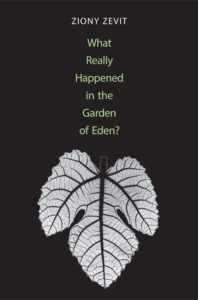 Title: What Really Happened in the Garden of Eden?
Title: What Really Happened in the Garden of Eden?
Author: Ziony Zevit
Publisher: Yale University Press
Genre: Biblical scholarship
Year Published: 2013
Number of Pages: 36
Reviewed by Erik Champenois
Written by a Biblical scholar, this book retranslates and analyzes the Garden of Eden story based on what an ancient Hebraic understanding of the text would have been as opposed to a modern Judaic or Christian interpretation.
Zevit starts by reviewing just how widespread and influential the traditional interpretation of the story is to Western culture, but notes that this interpretation, based on a “fall” from an idyllic state, is one that is alien to ancient Judea. That interpretation didn’t come about until Hellenism influenced Judaic and Christian readings, merging the Garden of Eden with Greek conceptions of a Golden Age. Zevit notes that no Israelite prophet ever alludes negatively to the events in the Garden, though there were different responses given as to whether people were punished for the sins of their ancestors or solely responsible for their own sins. But under the influence of Greek thought, Jews eventually looked as far back as the first generation to find reasons for humanity’s sinful nature. This resulted in reading the story of the Garden as one that involved a negative fall for all mankind.
Zevit counters this interpretation by dissecting the text in small pieces, reviewing sub-sections of the Garden stories in separate chapters. He uses four modern English translations and then adds his own to get at the text from a linguistic as well as an analytic perspective. He sums up the story as one that explains the origins of humanity and human nature, and especially of ethical self-awareness.
Many of his findings are both interesting and compelling: the Garden was not an idyllic state of nonwork, for Adam was set to work as a laborer in the Garden from the beginning, and Eve was created expressly to help him in his labors. Eve wasn’t created from Adam’s rib, but from his penis: the word translated as rib means something lateral to a main axis and is likely a euphemism – this story being an etiology for why men don’t have a bone in their penis, as so many animals do, since that bone went into creating Eve. The craftiness of the serpent is made even clearer when the underlying Hebrew is explained: for example, repeating God’s command which was given in singular and masculine, makes it seem like the command may not have applied to Eve. Finally, Eve had already given birth to at least Cain before Adam and Eve left the Garden, as is clear from the Hebrew in Genesis 4:1 and from the fact that Adam names Eve “the mother of all living” while still in the Garden.
As an LDS reader, how do Zevit’s findings align with or impact interpretations of LDS scripture and theology, especially in the Book of Mormon? I haven’t done enough close reading or contemplation to arrive at firmer conclusions, but here are some first tentative thoughts. First of all, the insight that earlier understandings of the Garden story were changed through the influence of Greek thought aligns well with Nephi’s vision in the Book of Mormon of Gentiles changing or diluting the plain and precious truths of the Bible after the Bible goes from the Jews to the Gentiles. Secondly, however, and somewhat opposed to this first point, Zevit’s conclusion that the original story isn’t about an actual “Fall” does not align as well with LDS scripture and theology – in spite of the LDS teaching that the fall was a positive development, 2 Nephi 2:22-23 still describes the fall as a change from endless and unchangeable conditions and states that Adam and Eve had no children until after the fall.
One solution is to view the Book of Mormon as drawing directly on later understandings of the Garden story available to Joseph Smith than on a more ancient, pre-Greek reading. In this reading, the Book of Mormon is either 19th century scripture without ancient provenance or it is a 19th century expansion and adaptation of ancient scripture which draws on post-Book of Mormon theological understandings.
On the other hand, the Book of Mormon self-consciously builds on and adapts earlier traditions in ways that would be quite different from contemporary or older Judaic understandings. For example, one of the first times Nephi mentions the Messiah he feels the need to explain that this Messiah is the Savior of the world (1 Nephi 10:4). When Nephi quotes and applies Isaiah to his people he specifically states that he is “likening” the text as he expands and applies it to a new setting. And Lehi’s reading of the Garden story in 2 Nephi 2 follows his comments that “according to the things which I have read, [he] must needs suppose” that an angel fell from heaven and became the devil. In saying this, Lehi is interpreting or adapting scripture to tell us something it originally may not have been understood as saying. While the original Garden story may not have meant what it came to mean for the Nephites or for modern LDS theology, that doesn’t necessarily militate against those meanings being “wrong.” As we see from the Hebrew Bible to the New Testament to modern LDS scripture, scripture itself is in a constant process of reinterpretation, addition, and expansion. Indeed, the Book of Mormon and modern scripture draw not only on more modern interpretations of the Garden story but on their own unique take and interpretation of the original story.
To the LDS reader, therefore, Zevit’s reading and conclusions of the Garden story are helpful in understanding how the story would itself have been read originally, but are merely a starting point for how the LDS reader should read the story based on our unique scriptural take.
